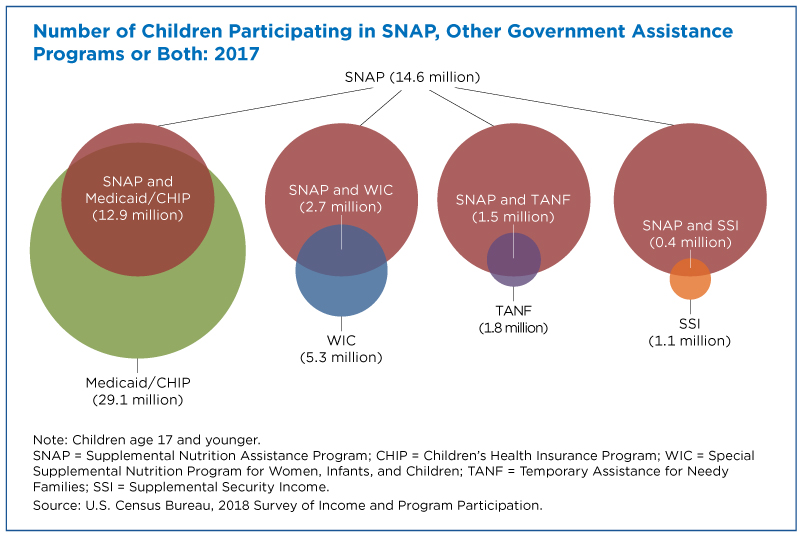Nearly a Third of Children Who Receive SNAP Participate in Two or More Additional Programs
About 92% of children who received Supplemental Nutrition Assistance Program (SNAP) benefits in 2017 received at least one other form of assistance and nearly a third received benefits from two or more additional programs.
An estimated 14.6 million (or one in five) U.S. children participated in SNAP — formerly known as food stamps — in 2017, according to recently released U.S. Census Bureau estimates using data from the 2018 Survey of Income and Program Participation (SIPP).
In 2017, fewer than one in 10 children participating in SNAP did not receive benefits from any of the other programs examined here.
The new data reveal the array of programs children who receive SNAP and their parents may rely on to meet children’s basic needs:
- Medicaid and the Children’s Health Insurance Program (CHIP).
- Special Supplemental Nutrition Program for Women, Infants, and Children (WIC).
- Temporary Assistance for Needy Families (TANF).
- Supplemental Security Income (SSI).
- Social Security (children receiving benefits because a parent is disabled, retired, or deceased).
When One Benefit is Not Enough
In 2017, fewer than one in 10 children participating in SNAP did not receive benefits from any of the other programs examined here.
The majority (six in 10) received one other benefit, and three in 10 received benefits from two or more additional programs.
Among children participating in SNAP, the most common additional benefit received was Medicaid/CHIP; 89% of children getting SNAP received both in 2017.
Of the programs examined here, the second most common benefit among child SNAP recipients was WIC. Nearly 20% of children getting SNAP also received WIC.
TANF or SSI benefits were less common for children who received SNAP. Roughly one in 10 also got TANF and only one in 40 also got SSI.
Though not examined here, the National School Lunch Program and the School Breakfast Program are additional sources of nutritional assistance for school-aged children receiving SNAP. Recent Census Bureau estimates also provide detail about children receiving free or reduced-price school meals.
Program Size and Eligibility
The key reasons programs overlap differently has a lot to do with the size of the programs and eligibility criteria.
SNAP provides benefits to more children than all other programs examined except Medicaid. Because of program size differences, however, even if all recipients of a smaller program received SNAP, most SNAP recipients would not be covered by that smaller program.
For example, most children (about 80%) who received TANF benefits also received SNAP in 2017 but only one in 10 who received SNAP also received TANF.
Eligibility for each of these programs is primarily based on income and asset thresholds often tied to federal poverty guidelines.
For example, although Medicaid and CHIP eligibility vary by state, even states with the most restrictive Medicaid/CHIP eligibility guidelines have income thresholds greater than the SNAP income eligibility threshold.
Therefore, children whose families have low enough income to be eligible for Medicaid/CHIP are almost always eligible for SNAP, too.
On the other hand, not only do SNAP and WIC income requirements differ but, unlike SNAP, WIC is limited to children younger than five.
All eligibility differences, including income and age, help explain both the difference in relative size of the programs and the varying overlaps in program receipt.
Michael D. King and Katherine G. Giefer are survey statisticians in the Census Bureau’s Program Participation and Income Transfers Branch.
Subscribe
Our email newsletter is sent out on the day we publish a story. Get an alert directly in your inbox to read, share and blog about our newest stories.
Contact our Public Information Office for media inquiries or interviews.
-
America Counts StoryMost Families With 2018 SNAP Benefits Had At Least One Person WorkingJuly 21, 2020Most families who received Supplemental Nutrition Assistance Program benefits had at least one worker and about a third included two or more workers.
-
America Counts StoryOne in Seven Social Safety Net Recipients in 2017 Were College GradsMay 12, 2021At least 3.7 million college graduates participated in social safety net programs in 2017.
-
America Counts StoryDemographic SNAPshot: Not All Eligible for Food Assistance Gets AidFebruary 02, 2021A new data visualization shows the demographic characteristics of people eligible for the Supplemental Nutrition Assistance Program and those who receive it.
-
Business and EconomyEconomic Census Geographic Area Statistics Data Now AvailableApril 07, 2025A new data visualization based on the 2022 Economic Census shows the changing business landscape of 19 economic sectors across the United States.
-
Income and PovertyWhat Sources of Income Do People Rely On?April 02, 2025A new interactive data tool shows income sources for hundreds of demographic and economic characteristic combinations.
-
Business and EconomyBig Improvements to the Annual Integrated Economic Survey (AIES)March 26, 2025The Census Bureau is making several changes and enhancements to capture 2024 economic data based on feedback from last year’s survey.
-
PopulationOnly 50 U.S. Counties Had Populations Over a Million in 2024March 17, 2025A new data visualization highlights U.S. counties between 1970 and 2024 whose populations ever surpassed a million.







